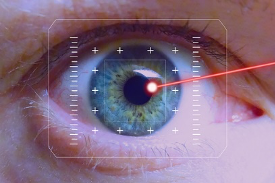EDOF IOLs are the result of a new technology designed to improve the range and quality of vision, especially at intermediate distances (such as when working at a computer).
Historically, the options used for pseudophakic correction (i.e. through lens replacement) of presbyopia have been monofocal or multifocal intraocular lenses (IOLs); however, both options have strengths and weaknesses.
 Le monofocal intraocular lenses can provide patients with good visual quality through monovision, but can also result in some loss of depth perception and do not provide optimal visual acuity at intermediate distances.
Le monofocal intraocular lenses can provide patients with good visual quality through monovision, but can also result in some loss of depth perception and do not provide optimal visual acuity at intermediate distances.
On the other hand, the Multifocal IOLs may have diffractive or refractive technology, which allows patients to obtain a fuller visual range and greater independence from spectacles than monofocal IOLs, they do, however, have negative effects on contrast sensitivity and increase the possibility of visual disturbances (glare and/or halos), especially in low-light conditions.
EDOF technology, on the other hand, aims at bridging the gap between monofocal and multifocal intraocular lenses by providing better visual acuity at intermediate distances, decreasing visual disturbances such as glare and halos, and ensuring better contrast sensitivity. Although most EDOF IOLs provide good to excellent distance visual acuity, improved intermediate visual acuity and functional near visual acuity, other attributes such as a certain degree of loss of contrast sensitivity are specific and depend on the design of the individual EDOF IOL.
EDOF intraocular lens technology and design
- Design with small optical aperture. EDOF IOLs with a small optical aperture design block peripheral blurred light rays through an opaque mask (3.23 mm wide) while allowing central and paracentral light rays to pass through the central aperture (1.36 mm). Patients with naturally large pupils may experience an increase in visual disturbances (halo) under mesopic conditions or a decrease in the blur range due to the small diameter of the optic.
- Bioanalogue technology. The EDOF IOL with bioanalogue technology is a bioanalogue hydrogel intraocular lens designed to emulate the crystalline lens with a similar shape, no haptic perception and a refractive power that decreases from the centre to the periphery. This lens has a larger surface area than conventional intraocular lenses and may not be suitable for patients with very shallow anterior chambers.
- Diffractive optics. Several EDOF IOLs use this optic. Some have a biconvex diffractive surface, aspheric front and achromatic back with a flake design and the ability to reduce chromatic aberration. Others have an aspherical diffractive design, chromatic correction and softer phase zones with smaller angles that optimise contrast sensitivity and minimise light scattering and visual side disturbances.
- Non-refractive optics, asphericity. This intraocular lens has a non-refractive design comprising three zones: a central zone with positive spherical aberration, an intermediate zone with negative spherical aberration and a monofocal outer zone with optically efficient transition zones. These IOLs are characterised by the creation of a single continuous focus, which should enable high-quality vision at all distances while minimising dysphotopsia.
In vivo Outcome of EDOF intraocular lenses with spherical aberration
Several studies have analysed the in vivo performance of the spherical aberration lens, Mini WELL Ready EDOF (SIFI, IT), and confirmed the quality of vision achieved by implanted patients. These results were further confirmed by a very recent study published in International Ophthalmology which assessed the optical quality and visual performance of patients implanted with Mini WELL Ready EDOF IOLs. The study analysed 38 implanted eyes that were assessed 3 months after surgery. The results revealed good levels of visual acuity (corrected and uncorrected) at all distances, as demonstrated by the questionnaire completed by the patients at the end of the course. Of particular note was the high level of intermediate visual acuity, a visual distance historically difficult to correct satisfactorily in IOL implant surgery. Excellent intermediate vision was not achieved at the cost of compromising distance vision, which remained high, nor did it reduce near vision to unacceptable levels. This ability to change focus from distance to near or vice versa is reflected in the patient satisfaction score, which is particularly high. In fact, when asked "Do you wear glasses in any situation?", the majority of patients answered no, thus demonstrating that they have gained independence from glasses. The good scores on the discrimination index also demonstrated a high ability to discriminate peripheral light stimuli around a small, high-brightness central stimulus against a dark background. This result is also reflected in the low level of subjectively perceived haloes that resulted in the 78% of the subjects driving at night being satisfied.
The study reveals that the implantation of the Mini WELL Ready EDOF IOL was very satisfactory for patients (79% of patients reported a high degree of satisfaction), of whom 95% would undergo the procedure again. The study demonstrates that the Mini WELL Ready EDOF IOL has good optical and visual quality with a high level of patient satisfaction and appears to be a valuable option for providing good visual quality, unaided at different distances, while minimising visual disturbances.
Bibliography:
- Kanclerz P. et al. Extended Depth-of-Field Intraocular Lenses: An Update. Asia Pac J Ophthalmol (Phila) 2020; 9:194-202.
- Thomas Kohnen. et al. Extended depth-of-focus technology in intraocular lenses. J Cataract Refract Surg. 2020 Feb;46(2):298-304.
- Ruiz-Mesa R. et al. Optical and visual quality assessment of an extended depth-of-focus intraocular lens based on spherical aberration of different sign. Int Ophthalmol. 2021 Jan 2.
Dr. Carmelo Chines
Direttore responsabile
